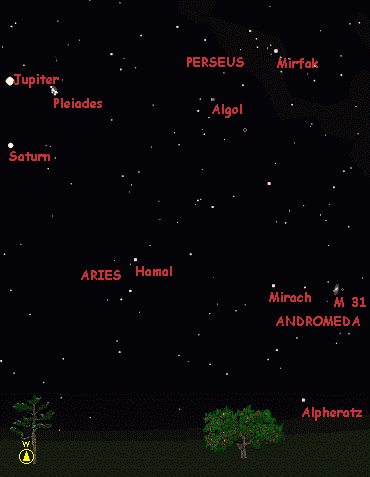





Thursday's Classroom

| Volume 7 Issue 02 | February 2001 | |
| What's Up? -- February 2001 | ||||||||||||||||||||||
 One of the more interesting
stars to observe, beside our own, are the variable stars. These stars, as the name suggests, have a brightness
that varies over a period of time. The variability of a star's brightness could be a result of the instability of a star and as it expands and contracts the changing brightness
may be observed. Other variable stars, such as Algol, have a range of brightness due to a companion
star. Algol is an example of an eclipsing variable star, a system wherein one star orbits another, and at relatively
regular intervals, passes between our line of sight to the other star - in effect, eclipsing it.
One of the more interesting
stars to observe, beside our own, are the variable stars. These stars, as the name suggests, have a brightness
that varies over a period of time. The variability of a star's brightness could be a result of the instability of a star and as it expands and contracts the changing brightness
may be observed. Other variable stars, such as Algol, have a range of brightness due to a companion
star. Algol is an example of an eclipsing variable star, a system wherein one star orbits another, and at relatively
regular intervals, passes between our line of sight to the other star - in effect, eclipsing it.
As a variable star Algol has some distinct advantages over other variable stars in that its periods is less than 3 days, and the change from minimum back to maximum lasts about 10 hours. Somewhat like a solar eclipse the approximate time from what we call first contact until last contact (using a solar eclipse as an example) can be viewed during one night. To observe Algol use the table below as a guide to find a minimum time for Algol during the evening at a time such that it is still dark 10 hours later to view Algol at its maximum. Or, using the table below as a guide, find a minimum time for Algol before the sun rises such that 10 hours later it is evening and dark enough to see Algol at its maximum.
Read more about this variable star at the AAVSO web site. |
||||||||||||||||||||||
 These Articles, activities, and the monthly newsletter may be reproduced for classroom use; inclusion in another newsletter,
or linked with another web site, without written permission. Any other use will require written permission.
These Articles, activities, and the monthly newsletter may be reproduced for classroom use; inclusion in another newsletter,
or linked with another web site, without written permission. Any other use will require written permission.